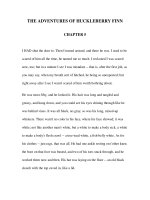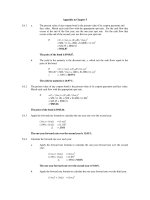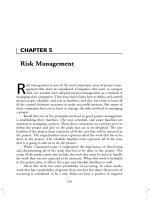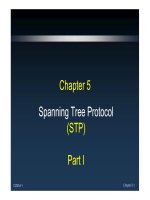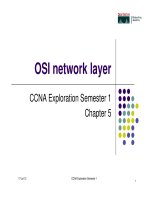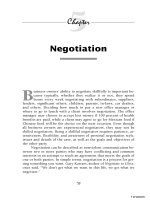A Semantic Web Primer - Chapter 5 ppt
Bạn đang xem bản rút gọn của tài liệu. Xem và tải ngay bản đầy đủ của tài liệu tại đây (316.21 KB, 28 trang )
5 Logic and Inference: Rules
5.1 Introduction
From an abstract viewpoint, the subjects of the previous chapters were re-
lated to the representation of knowledge: knowledge about the content of Web
resources, and knowledge about the concepts of a domain of discourse and
their relationships (ontology).
Knowledge representation had been studied long before the emergence of
the World Wide Web, in the area of artificial intelligence and, before that,
in philosophy. In fact, it can be traced back to ancient Greece; Aristotle is
considered to be the father of logic. Logic is still the foundation of knowledge
representation, particularly in the form of predicate logic (also known as first-
order logic). Here we list a few reasons for the popularity and importance of
logic:
•Itprovides a high-level language in which knowledge can be expressed
in a transparent way. And it has a high expressive power.
•Ithas a well-understood formal semantics, which assigns an unambigu-
ous meaning to logical statements.
• There is precise notion of logical consequence, which determines whether
a statement follows semantically from a set of other statements (premises).
In fact, the primary original motivation of logic was the study of objective
laws of logical consequence.
• There exist proof systems that can automatically derive statements syn-
tactically from a set of premises.
• There exist proof systems for which semantic logical consequence coin-
cides with syntactic derivation within the proof system. Proof systems
TLFeBOOK
TLFeBOOK
152 5 Logic and Inference: Rules
should be sound (all derived statements follow semantically from the
premises) and complete (all logical consequences of the premises can be
derived in the proof system).
•Predicate logic is unique in the sense that sound and complete proof sys-
tems do exist. More expressive logics (higher-order logics) do not have
such proof systems.
• Because of the existence of proof systems, it is possible to trace the proof
that leads to a logical consequence. In this sense, the logic can provide
explanations for answers.
The languages of RDF and OWL (Lite and DL) can be viewed as specializa-
tions of predicate logic. The correspondence was illustrated by the axiomatic
semantics in the form of logical axioms.
One justification for the existence of such specialized languages is that they
provide a syntax that fits well with the intended use (in our case, Web lan-
guages based on tags). The other major justification is that they define rea-
sonable subsets of logic. As mentioned in section 4.1, there is a trade-off
between the expressive power and the computational complexity of certain
logics: the more expressive the language, the less efficient (in the worst case)
the corresponding proof systems. As we stated, OWL Lite and OWL DL cor-
respond roughly to a description logic, a subset of predicate logic for which
efficient proof systems exist.
Another subset of predicate logic with efficient proof systems comprises
the so-called rule systems (also known as Horn logic or definite logic programs).
Arule has the form
A
1
, A
n
→ B
where A
i
and B are atomic formulas. In fact, there are two intuitive ways of
reading such a rule:
1. If A
1
, ,A
n
are known to be true, then B is also true. Rules with this
interpretation are referred to as deductive rules.
2. If the conditions A
1
, ,A
n
are true, then carry out the action B.Rules
with this interpretation are referred to as reactive rules.
Both views have important applications. However, in this chapter we take
the deductive approach. We study the language and possible queries that
TLFeBOOK
TLFeBOOK
5.1 Introduction 153
one can ask, as well as appropriate answers. Also we outline the working of
aproof mechanism that can return such answers.
It is interesting to note that description logics and Horn logic are orthogo-
nal in the sense that neither of them is a subset of the other. For example, it
is impossible to assert that persons who study and live in the same city are
“home students” in OWL, whereas this can be done easily using rules:
studies(X, Y ),lives(X, Z),loc(Y, U),loc(Z, U) → homeStudent(X)
On the other hand, rules cannot assert the information that a person is either
a man or a woman, whereas this information is easily expressed in OWL
using disjoint union.
Then we turn our attention to another kind of rules. We give a simple
example. Suppose an online vendor wants to give a special discount if it is a
customer’s birthday. An easy way to represent this application with rules is
as follows:
R1:If birthday, then special discount.
R2:If not birthday, then not special discount.
This solution works properly in case the birthday is known. But imagine a
customer who refuses to provide his birthday because of privacy concerns.
In such a case, the preceding rules cannot be applied because their premises
are not known. To capture this situation we need to write something like
R1:If birthday, then special discount.
R2
: If birthday is not known, then not special discount.
However, the premise of rule R2
is not within the expressive power of predi-
cate logic. Thus we need a new kind of rule system. We note that the solution
with rules R1 and R2 works in case we have complete information about the
situation (for example, either birthday or not birthday). The new kind of
rule system will find application in cases where the available information is
incomplete.
Predicate logic and its special cases are monotonic in the following sense: if
a conclusion can be drawn, it remains valid even if new knowledge becomes
available. But if rule R2
is applied to derive “not special discount,” then this
conclusion may become invalid if the customer’s birthday becomes known
at a later stage and it happens to coincide with the purchase date. Thus we
talk of nonmonotonic rules to distinguish them from monotonic rules (which
TLFeBOOK
TLFeBOOK
154 5 Logic and Inference: Rules
are a special case of predicate logic). In this chapter, we will discuss both
monotonic and nonmonotonic rules.
Our final concern will be the exchange of rules across different applica-
tions. For example, an online store might wish to make its pricing, refund,
and privacy policies, which are expressed using rules, accessible to intelli-
gent agents. The Semantic Web approach is to express the knowledge in a
machine-accessible way using one of the Web languages we have already
discussed. In this chapter, we show how rules can be expressed in XML-like
languages (“rule markup languages”). Some applications of rule systems are
discussed in chapter 6.
In this chapter we give an example using monotonic rules (a subset of
predicate logic called Horn logic) in section 5.2. Sections 5.3 and 5.4 describe
the syntax and semantics of Horn logic, and section 5.5 describes the syntax
of nonmonotonic rules.
Section 5.6 presents an example of nonmonotonic rules. Finally, sections
5.7 and 5.8 describe an XML-based representation of monotonic and non-
monotonic rules.
5.2 Example of Monotonic Rules: Family Relationships
Imagine a database of facts about some family relationships. Suppose that
the database contains facts about the following base predicates:
mother(X, Y ) X is the mother of Y
father(X, Y ) X is the father of Y
male(X) X is male
female(X) X is female
Then we can infer further relationships using appropriate rules. First, we can
define a predicate parent:aparent is either a father or a mother.
mother(X, Y ) → parent(X, Y )
father(X, Y ) → parent(X,Y )
Then we can define a brother to be a male person sharing a parent:
male(X), parent(P, X),parent(P, Y ),notSame(X, Y ) →
brother(X, Y )
TLFeBOOK
TLFeBOOK
5.3 Monotonic Rules: Syntax 155
The predicate notSame denotes inequality; we assume that such facts are
kept in a database. Of course, every practical logical system offers conve-
nient ways of expressing equality and inequality, but we chose the abstract
solution to keep the discussion general.
Similarly, sister is defined as follows:
female(X), parent(P, X),parent(P, Y ),notSame(X, Y ) →
sister(X, Y )
An uncle is a brother of a parent:
brother(X, P ),parent(P, Y ) → uncle(X, Y )
A grandmother is the mother of a parent:
mother(X, P ),parent(P, Y ) → grandmother(X, Y )
An ancestor is either a parent or an ancestor of a parent:
parent(X, Y ) → ancestor(X, Y )
ancestor(X, P ),parent(P, Y ) → ancestor(X, Y )
5.3 Monotonic Rules: Syntax
Let us consider a simple rule stating that all loyal customers aged over 60 are
entitled to a special discount:
loyalCustomer(X),age(X) > 60 → discount(X)
We distinguish some ingredients of rules:
• variables, which are placeholders for values: X
• constants, which denote fixed values: 60
• predicates, which relate objects: loyalCustomer, >
• function symbols, which return a value for certain arguments: age
TLFeBOOK
TLFeBOOK
156 5 Logic and Inference: Rules
5.3.1 Rules
Arule has the form
B
1
, ,B
n
→ A
where A, B
1
, ,B
n
are atomic formulas. A is the head of the rule, and
B
1
, ,B
n
are the premises of the rule. The set {B
1
, ,B
n
} is referred to
as the body of the rule.
The commas in the rule body are read conjunctively: if B
1
and B
2
and
and B
n
are true, then A is also true (or equivalently, to prove A it is sufficient
to prove all B
1
, ,B
n
).
Note that variables may occur in A, B
1
, ,B
n
. For example,
loyalCustomer(X),age(X) > 60 → discount(X)
This rule is applied for any customer: if a customer happens to be loyal and
over 60, then she gets the discount. In other words, the variable X is implic-
itly universally quantified (using ∀X). In general, all variables occurring in
arule are implicitly universally quantified.
In summary, a rule r
B
1
, ,B
n
→ A
is interpreted as the following formula, denoted by pl(r):
∀X
1
∀X
k
((B
1
∧ ∧ B
n
) → A)
or equivalently,
∀X
1
∀X
k
(A ∨¬B
1
∨ ∨¬B
n
)
where X
1
, ,X
k
are all variables occurring in A, B
1
, ,B
n
.
5.3.2 Facts
A fact is an atomic formula, such as loyalCustomer(a345678);itsays that
the customer with ID a345678 is loyal. The variables of a fact are implicitly
universally quantified.
5.3.3 Logic Programs
A logic program P is a finite set of facts and rules. Its predicate logic transla-
tion pl(P) is the set of all predicate logic interpretations of rules and facts in
P .
TLFeBOOK
TLFeBOOK
5.3 Monotonic Rules: Syntax 157
5.3.4 Goals
A goal denotes a query G asked to a logic program. It has the form
B
1
, ,B
n
→
If n =0we have the empty goal ✷.
Our next task is to interpret goals in predicate logic. Using the ideas we de-
veloped before (interpretations of commas as conjunction, implicit universal
quantification) we get the following interpretation:
∀X
1
∀X
k
(¬B
1
∨ ∨¬B
n
)
This formula is the same as pl(r), with the only difference that the rule head
A is omitted
1
.
An equivalent representation in predicate logic is
¬∃X
1
∃X
k
(B
1
∧ ∧ B
n
)
where X
1
, ,X
k
are all variables occurring in B
1
, ,B
n
. Let us briefly
explain this formula. Suppose we know
p(a)
and we have the goal
p(X) →
Actually, we want to know whether there is a value for which p is true. We
expect a positive answer because of the fact p(a). Thus p(X) is existentially
quantified. But then why do we negate the formula? The explanation is that
we use a proof technique from mathematics called proof by contradiction.This
technique proves that a statement A follows from a statement B by assuming
that A is false and deriving a contradiction, when combined with B. Then A
must follow from B.
In logic programming we prove that a goal can be answered positively by
negating the goal and proving that we get a contradiction using the logic
program. For example, given the logic program
p(a)
1. Note that the formula is equivalent to ∀X
1
∀X
k
(false ∨¬B
1
∨ ∨¬B
n
),soamissing
rule head can be thought of as a contradiction false.
TLFeBOOK
TLFeBOOK
158 5 Logic and Inference: Rules
and the goal
¬∃Xp(X)
we get a logical contradiction: the second formula says that no element has
the property p, but the first formula says that the value of a does have the
property p. Thus ∃Xp(X) follows from p(a).
5.4 Monotonic Rules: Semantics
5.4.1 Predicate Logic Semantics
One way of answering a query is to use the predicate logic interpretation of
rules, facts, and queries, and to make use of the well-known semantics of
predicate logic. To be more precise, given a logic program P and a query
B
1
, ,B
n
→
with the variables X
1
, ,X
k
,weanswer positively if, and only if,
pl(P ) |= ∃X
1
∃X
k
(B
1
∧ ∧ B
n
) (1)
or equivalently, if
pl(P ) ∪{¬∃X
1
∃X
k
(B
1
∧ ∧ B
n
)} is unsatisfiable (2)
In other words, we give a positive answer if the predicate logic representa-
tion of the program P, together with the predicate logic interpretation of the
query, is unsatisfiable (a contradiction).
The formal definition of the semantic concepts of predicate logic is found
in the literature. Here we just give an informal presentation. The compo-
nents of the logical language (signature) may have any meaning we like. A
predicate logic model A assigns a certain meaning. In particular, it consists of
•adomain dom(A),anonempty set of objects about which the formulas
make statements
•anelement from the domain for each constant
•aconcrete function on dom(A) for every function symbol
•aconcrete relation on dom(A) for every predicate
TLFeBOOK
TLFeBOOK
5.4 Monotonic Rules: Semantics 159
The meanings of the logical connectives ¬, ∨, ∧, →, ∀, ∃ are defined according
to their intuitive meaning: not, or, and, implies, for all, there is. This way we
define when a formula is true in a model A, denoted as A|= ϕ.
A formula ϕ follows from a set M of formulas if ϕ is true in all models A in
which M is true (that is, all formulas in M are trueinA).
Now we are able to explain (1) and (2). Regardless of how we interpret the
constants, predicates, and function symbols occurring in P and the query,
once the predicate logic interpretation of P is true, ∃X
1
∃X
k
(B
1
∧ ∧B
n
)
must be true, too. That is, there are values for the variables X
1
, ,X
k
such
that all atomic formulas B
i
become true.
For example, suppose P is the program
p(a)
p(X) → q(X)
Consider the query
q(X) →
Clearly, q(a) follows from pl(P). Therefore, ∃Xq(X) follows from pl(P), thus
pl(P ) ∪{¬∃Xq(X)} is unsatisfiable, and we give a positive answer. But if we
consider the query
q(b) →
then we must give a negative answer because q(b) does not follow from
pl(P ).
The other kind of semantics for logic programs, least Herbrand model se-
mantics, requires more technical treatment, and is not discussed here.
5.4.2 Ground and Parameterized Witnesses
So far we have focused on yes/no answers to queries. However, such an-
swers are not necessarily optimal. Suppose that we have the fact
p(a)
and the query
p(X) →
TLFeBOOK
TLFeBOOK
160 5 Logic and Inference: Rules
The answer yes is correct but not satisfactory. It resembles the joke where
you are asked, “Do you know what time it is?”, and you look at your watch
and answer “yes.” In our example, the appropriate answer is a substitution
{X/a}
which gives an instantiation for X, making the answer positive. The constant
a is called a ground witness. Given the facts
p(a)
p(b)
there are two ground witnesses to the same query: a and b.Orequivalently,
we should return the substitutions:
{X/a}
{X/b}
While valuable, ground witnesses are not always the optimal answer. Con-
sider the logic program
add(X, 0,X)
add(X, Y, Z) → add(X,s(Y ),s(Z))
This program computes addition, if we read s as the “successor function,”
which returns as value the value of its argument plus 1. The third argument
of add computes the sum of its first two arguments. Consider the query
add(X, s
8
(0),Z) →
Possible ground witnesses are determined by the substitutions
{X/0,Z/s
8
(0)}
{X/s(0),Z/s
9
(0)}
{X/s(s(0)),Z/s
10
(0)}
However, the parameterized witness Z = s
8
(X) is the most general way to
witness the existential query
∃X∃Z add(X, s
8
(0),Z)
TLFeBOOK
TLFeBOOK
5.5 Nonmonotonic Rules: Motivation and Syntax 161
The computation of such most general witnesses is the primary aim of the
proof theory, called SLD resolution,
2
the presentation of which is beyond the
scope of this book.
5.5 Nonmonotonic Rules: Motivation and Syntax
5.5.1 Informal Discussion
Now we turn our attention to nonmonotonic rule systems. So far, once the
premises of a rule were proved, the rule could be applied and its head could
be derived as a conclusion. In nonmonotonic rule systems, a rule may not be
applied even if all premises are known because we have to consider contrary
reasoning chains. In general, the rules we consider from now on are called
defeasible, because they can be defeated by other rules. To allow conflicts
between rules, negated atomic formulas may occur in the head and the body of
rules. For example, we may write
p(X) → q(X)
r(X) →¬q(X)
To distinguish between defeasible rules and standard, monotonic rules, we
use a different arrow:
p(X) ⇒ q(X)
r(X) ⇒¬q(X)
In this example, given also the facts
p(a)
r(a)
we conclude neither q(a) nor ¬q(a).Itisatypical example of two rules block-
ing each other. This conflict may be resolved using priorities among rules.
Suppose we knew somehow that the first rule is stronger than the second;
then we could indeed derive q(a).
Priorities arise naturally in practice, and may be based on various princi-
ples:
2. SLD resolution stands for “selective linear resolution for definite clauses.”
TLFeBOOK
TLFeBOOK
162 5 Logic and Inference: Rules
• The source of one rule may be more reliable than the source of the second
rule, or may have higher authority. For example, in law, federal law pre-
empts state law. And in business administration, higher management has
more authority than middle management.
• One rule may be preferred over another because it is more recent.
• One rule may be preferred over another because it is more specific. A
typical example is a general rule with some exceptions; in such cases, the
exceptions are stronger than the general rule.
Specificity may often be computed based on the given rules, but the other
two principles cannot be determined from the logical formalization. There-
fore, we abstract from the specific prioritization principle used, and assume
the existence of an external priority relation on the set of rules. To express the
relation syntactically, we extend the rule syntax to include a unique label, for
example,
r
1
: p(X) ⇒ q(X)
r
2
: r(X) ⇒¬q(X)
Then we can write
r
1
>r
2
to specify that r
1
is stronger than r
2
.
We do not impose many conditions on >.Itisnot even required that the
rules form a complete ordering. We only require the priority relation to be
acyclic. That is, it is impossible to have cycles of the form
r
1
>r
2
> >r
n
>r
1
Note that priorities are meant to resolve conflicts among competing rules.In
simple cases two rules are competing only if the head of one rule is the nega-
tion of the head of the other. But in applications it is often the case that once a
predicate p is derived, some other predicates are excluded from holding. For
example, an investment consultant may base his recommendations on three
levels of risk investors are willing to take: low, moderate, and high. Obvi-
ously, only one risk level per investor is allowed to hold at any given time.
Technically, these situations are modeled by maintaining a conflict set C(L)
for each literal L. C(L) always contains the negation of L but may contain
more literals.
TLFeBOOK
TLFeBOOK
5.6 Example of Nonmonotonic Rules: Brokered Trade 163
5.5.2 Definition of the Syntax
A defeasible rule has the form
r : L
1
, ,L
n
⇒ L
where r is the label, {L
1
, ,L
n
} the body (or premises), and L the head of
the rule. L, L
1
, ,L
n
are positive or negative literals (a literal is an atomic
formula p(t
1
, ,t
m
) or its negation ¬p(t
1
, ,t
m
)). No function symbols
may occur in the rule.
3
Sometimes we denote the head of a rule as head(r),
and its body as body(r). Slightly abusing notation, sometimes we use the
label r to refer to the whole rule.
A defeasible logic program is a triple (F, R, >) consisting of a set F of facts,
a finite set R of defeasible rules, and an acyclic binary relation > on R (pre-
cisely, a set of pairs r>r
where r and r
are labels of rules in R).
5.6 Example of Nonmonotonic Rules: Brokered Trade
This example shows how rules can be used in an electronic commerce appli-
cation (which will ideally run on the Semantic Web). Brokered trades take
place via an independent third party, the broker. The broker matches the
buyer’s requirements and the sellers’ capabilities, and proposes a transaction
when both parties can be satisfied by the trade.
As a concrete application we will discuss apartment renting,
4
an activity
that is common and often tedious and time-consuming. Appropriate Web
services can reduce the effort considerably. We begin by presenting the po-
tential renter’s requirements.
Carlos is looking for an apartment of at least 45 sq m with at least two
bedrooms. If it is on the third floor or higher, the house must have an
elevator. Also, pet animals must be allowed.
Carlos is willing to pay $300 for a centrally located 45 sq m apartment,
and $250 for a similar flat in the suburbs. In addition, he is willing to
pay an extra $5 per square meter for a larger apartment, and $2 per
square meter for a garden.
3. This restriction is imposed for technical reasons, the discussion of which is beyond the scope
of this chapter.
4. In this case, the landlord takes the role of the abstract seller.
TLFeBOOK
TLFeBOOK
164 5 Logic and Inference: Rules
He is unable to pay more than $400 in total. If given the choice, he
would go for the cheapest option. His second priority is the presence
of a garden; his lowest priority is additional space.
5.6.1 Formalization of Carlos’s Requirements
We use the following predicates to describe properties of apartments:
size(x, y) y is the size of apartment x (in sq m)
bedrooms(x, y) x has y bedrooms
price(x, y) y is the price for x
floor(x, y) x is on the yth floor
garden(x, y) x has a garden of size y
lift(x) there is an elevator in the house of x
pets(x) pets are allowed in x
central(x) x is centrally located
We also make use of the following predicates:
acceptable(x) flat x satisfies Carlos’s requirements
offer(x, y) Carlos is willing to pay $ y for flat x
Now we present Carlos’s firm requirements. Any apartment is a priori ac-
ceptable.
r
1
: ⇒ acceptable(X)
However, Y is unacceptable if one of Carlos’s requirements is not met.
r
2
: bedrooms(X, Y ),Y <2 ⇒¬acceptable(X)
r
3
: size(X,Y ),Y < 45 ⇒¬acceptable(X)
r
4
: ¬pets(X) ⇒¬acceptable(X)
r
5
: floor(X, Y ),Y >2, ¬lift(X) ⇒¬acceptable(X)
r
6
: price(X, Y ),Y >400 ⇒¬acceptable(X)
Rules r
2
-r
6
are exceptions to rule r
1
,soweadd
r
2
>r
1
,r
3
>r
1
,r
4
>r
1
,r
5
>r
1
,r
6
>r
1
TLFeBOOK
TLFeBOOK
5.6 Example of Nonmonotonic Rules: Brokered Trade 165
Next we calculate the price Carlos is willing to pay for an apartment.
r
7
: size(X, Y ),Y ≥ 45,garden(X, Z), central(X) ⇒ offer(X, 300 +
2Z +5(Y − 45))
r
8
: size(X, Y ),Y ≥ 45,garden(X,Z), ¬central(X) ⇒ offer(X, 250 +
2Z +5(Y − 45))
An apartment is only acceptable if the amount Carlos is willing to pay is not
less than the price specified by the landlord (we assume no bargaining can
take place).
r
9
: offer(X, Y ),price(X, Z),Y <Z ⇒¬acceptable(X)
r
9
>r
1
5.6.2 Representation of Available Apartments
Each available apartment is given a unique name, and its properties are rep-
resented as facts. For example, apartment a
1
might be described as follows:
bedrooms(a
1
, 1)
size(a
1
, 50)
central(a
1
)
floor(a
1
, 1)
¬lift(a
1
)
pets(a
1
)
garden(a
1
, 0)
price(a
1
, 300)
The description of the available apartments are summarized in table 5.1. In
practice, the flats on offer could be stored in a relational database.
If we match Carlos’s requirements and the available apartments, we see
that
• flat a
1
is not acceptable because it has one bedroom only (rule r
2
)
• flats a
4
and a
6
are unacceptable because pets are not allowed (rule r
4
)
• for a
2
, Carlos is willing to pay $300, but the price is higher (rules r
7
and
r
9
)
• flats a
3
,a
5
, and a
7
are acceptable (rule r
1
)
TLFeBOOK
TLFeBOOK
166 5 Logic and Inference: Rules
Flat Bedrooms Size Central Floor Lift Pets Garden Price
a
1
1 50 yes 1 no yes 0 300
a
2
2 45 yes 0 no yes 0 335
a
3
2 65 no 2 no yes 0 350
a
4
2 55 no 1 yes no 15 330
a
5
3 55 yes 0 no yes 15 350
a
6
2 60 yes 3 no no 0 370
a
7
3 65 yes 1 no yes 12 375
Table 5.1 Available apartments
5.6.3 Selecting an Apartment
So far we have identified the apartments acceptable to Carlos. This selection
is valuable in itself, since it reduces the focus to relevant flats, which may
then be physically inspected. But it is also possible to reduce the number
further, even down to a single apartment, by taking further preferences into
account. Carlos’s preferences are based on price, garden size, and size, in
that order. We represent them as follows:
r
10
: cheapest(X) ⇒ rent(X)
r
11
: cheapest(X),largestGarden(X) ⇒ rent(X)
r
12
: cheapest(X),largestGarden(X),largest(X) ⇒ rent(X)
r
12
>r
10
r
12
>r
11
r
11
>r
10
Also, we need to specify that at most one apartment can be rented, using
conflict sets:
C(rent(x)) = {¬rent(x)}∪{rent(y) | y = x}
The prerequisites of these rules can be derived from the set of acceptable
apartments using further rules. Here we keep the discussion simple by just
stating the facts for our example:
TLFeBOOK
TLFeBOOK
5.7 Rule Markup in XML: Monotonic Rules 167
cheapest(a
3
)
cheapest(a
5
)
largest(a
3
)
largest(a
7
)
largestGarden(a
5
)
Now the theory is able to derive the decision to rent a
5
:
• Rule r
11
can be applied to a
5
.
• Rule r
10
can be applied to a
3
, thus establishing an attack. However, this
attack is successfully countered because r
11
is stronger than r
10
.
• This is indeed the only attack, because neither r
11
nor r
12
applies to any
other apartment.
Thus a selection has been made, and Carlos will soon move in.
5.7 Rule Markup in XML: Monotonic Rules
Our aim here is to make knowledge in the form of rules machine-accessible,
in accordance with the Semantic Web vision. We outline an encoding of
monotonic rules in XML.
5.7.1 Terms
Terms are represented using XML tags <term>, <function>, <var>,
and <const>. For example, the term
f(X,a, g(b, Y ))
is represented as follows:
<term>
<function>f</function>
<term>
<var>X</var>
</term>
<term>
<const>a</const>
TLFeBOOK
TLFeBOOK
168 5 Logic and Inference: Rules
</term>
<term>
<function>g</function>
<term>
<const>b</const>
</term>
<term>
<var>Y</var>
</term>
</term>
</term>
5.7.2 Atomic Formulas
For atomic formulas we use additionally the tag <atom> and the tag
<predicate>. For example, the formula
p(X, a, f(b, Y ))
is represented as follows:
<atom>
<predicate>p</predicate>
<term>
<var>X</var>
</term>
<term>
<const>a</const>
</term>
<term>
<function>f</function>
<term>
<const>b</const>
</term>
<term>
<var>Y</var>
</term>
</term>
</atom>
TLFeBOOK
TLFeBOOK
5.7 Rule Markup in XML: Monotonic Rules 169
Note that the distinction between function symbols, predicates, and con-
stants, implicit in the logical syntax we have used so far, becomes explicit
in XML.
5.7.3 Facts
A fact is just an atomic formula, enclosed by opening and closing <fact>
tags. For example, the fact p(a) is represented as follows:
<fact>
<atom>
<predicate>p</predicate>
<term>
<const>a</const>
</term>
</atom>
</fact>
5.7.4 Rules
Arule consist of a head and a body. A head is an atomic formula. The body is
a(possibly empty) sequence of atomic formulas. We use new tags <rule>,
<head>, and <body>. For example, the rule
p(X, a),q(Y,b) → r(X,Y )
is represented as follows:
<rule>
<head>
<atom>
<predicate>r</predicate>
<term>
<var>X</var>
</term>
<term>
<var>Y</var>
</term>
</atom>
</head>
TLFeBOOK
TLFeBOOK
170 5 Logic and Inference: Rules
<body>
<atom>
<predicate>p</predicate>
<term>
<var>X</var>
</term>
<term>
<const>a</const>
</term>
</atom>
<atom>
<predicate>q</predicate>
<term>
<var>Y</var>
</term>
<term>
<const>b</const>
</term>
</atom>
</body>
</rule>
5.7.5 Queries
Queries are represented as the bodies of rules, surrounded by <query>
tags.
5.7.6 A DTD
Aprogram consists of a number of rules and facts.
<!ELEMENT program ((rule|fact)*)>
A fact consists of an atomic formula.
<!ELEMENT fact (atom)>
Arule consists of a head and a body.
<!ELEMENT rule (head,body)>
TLFeBOOK
TLFeBOOK
5.7 Rule Markup in XML: Monotonic Rules 171
A head consists of an atomic formula.
<!ELEMENT head (atom)>
A body is a list of atomic formulas.
<!ELEMENT body (atom*)>
An atomic formula consists of a predicate, followed by a number of terms.
<!ELEMENT atom (predicate,term*)>
A term is a constant, a variable, or a composite term consisting of a function
symbol, followed by a number of terms.
<!ELEMENT term (const|var|(function,term*))>
Predicates, function symbols, constants, and variables are atomic types.
<!ELEMENT predicate (#PCDATA)>
<!ELEMENT function (#PCDATA)>
<!ELEMENT var (#PCDATA)>
<!ELEMENT const (#PCDATA)>
A query is a list of atomic formulas.
<!ELEMENT query (atom*)>
5.7.7 The Alternative Data Model of RuleML
RuleML is an important standardization effort in the area of rules in the con-
text of the Semantic Web. It uses similar ideas to those presented in the DTD
(figure 5.1 shows a comparison of tags used in the DTD and in RuleML.)
But RuleML has developed an alternative data model that combines features
of XML and RDF. Recall that in XML the order of elements is important,
whereas it is ignored in RDF.
RuleML is at present based on XML but uses RDF-like “role tags,” the
position of which in an expression is irrelevant. For example, if we use the
role tags <_head> and <_body>, the expression:
TLFeBOOK
TLFeBOOK
172 5 Logic and Inference: Rules
Our DTD RuleML
program rulebase
fact fact
rule imp
head _head
body _body
atom atom
atom* and
predicate rel
const ind
var var
Figure 5.1 Monotonic rules DTD versus RuleML
<rule>
<_head>
<atom>
<predicate>p</predicate>
<term>
<const>a</const>
</term>
</atom>
</_head>
<_body>
<atom>
<predicate>q</predicate>
<term>
<const>b</const>
</term>
</atom>
</_body>
</rule>
is equivalent to
<rule>
<_body>
<atom>
TLFeBOOK
TLFeBOOK
5.8 Rule Markup in XML: Nonmonotonic Rules 173
<predicate>q</predicate>
<term>
<const>b</const>
</term>
</atom>
</_body>
<_head>
<atom>
<predicate>p</predicate>
<term>
<const>a</const>
</term>
</atom>
</_head>
</rule>
although they are different under the XML data model, in which the order is
important. For a discussion of this idea, see Suggested Reading.
It should be clear that we can express in XML not only programs and
queries but also substitutions and proofs.
5.8 Rule Markup in XML: Nonmonotonic Rules
Compared to monotonic rules, nonmonotonic rules have the following syn-
tactic differences:
• There are no function symbols; therefore the term structure is flat.
• Negated atoms may occur in the head and the body of a rule.
• Each rule has a label.
• Apart from rules and facts, a program also contains priority statements.
5.8.1 An Example
Consider the defeasible program
r
1
: p(X) ⇒ s(X)
r
2
: q(X) ⇒¬s(X)
TLFeBOOK
TLFeBOOK
174 5 Logic and Inference: Rules
p(a)
q(a)
r
1
>r
2
We use a <stronger> tag to represent priorities, and an ID label in rules to
denote their name.
Rule r
1
is represented as follows:
<rule id="r1">
<head>
<atom>
<predicate>s</predicate>
<term>
<var>X</var>
</term>
</atom>
</head>
<body>
<atom>
<predicate>p</predicate>
<term>
<var>X</var>
</term>
</atom>
</body>
</rule>
Rule r
2
is represented accordingly. The fact p(a) is represented as follows:
<fact>
<atom>
<predicate>p</predicate>
<term>
<const>a</const>
</term>
</atom>
</fact>
And the priority relation r
1
>r
2
is represented as follows:
<stronger superior="r1" inferior="r2"/>
TLFeBOOK
TLFeBOOK
5.8 Rule Markup in XML: Nonmonotonic Rules 175
5.8.2 A DTD
Aprogram consists of a number of rules, facts, and priority relations.
<!ELEMENT program ((rule|fact|stronger)*)>
A fact consists of an atomic formula or its negation.
<!ELEMENT fact (atom|neg)>
<!ELEMENT neg (atom)>
Arule consists of a head and a body element, and an id attribute.
<!ELEMENT rule (head,body)>
<!ATTLIST rule
id ID #IMPLIED>
The rule head and body are defined as for monotonic rules, but may contain
negated atoms.
<!ELEMENT head (atom|neg)>
<!ELEMENT body ((atom|neg)*)>
An atomic formula consists of a predicate, followed by a number of variables
and constants.
<!ELEMENT atom (predicate,(var|const)*)>
A priority element uses two attributes, referring to the superior and the infe-
rior rule.
<!ELEMENT stronger EMPTY)>
<!ATTLIST stronger
superior IDREF #REQUIRED>
inferior IDREF #REQUIRED>
Predicates, constants, and variables are atomic types.
<!ELEMENT predicate (#PCDATA)>
<!ELEMENT var (#PCDATA)>
<!ELEMENT const (#PCDATA)>
A query is a list of atomic formulas.
<!ELEMENT query (atom*)>
TLFeBOOK
TLFeBOOK

